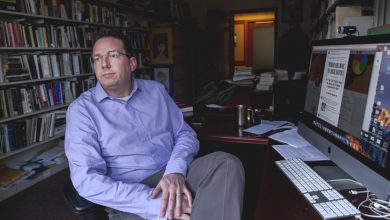More Colleges Are Hiring Crisis-Response Teams for Mental-Health Emergencies

Oregon State is the latest of several large universities to roll out teams of crisis responders in efforts to rethink campus safety and field more appropriate responses to students in some nonviolent emergencies, like mental-health or addiction crises.
Campus officials say the program, called OSU Assist, recognizes that many students from marginalized communities have negative experiences with the police that can be exacerbated when officers show up. In some situations, unarmed crisis responders may be better equipped to offer the help students need.
The OSU Assist team consists of four crisis responders, including mental-health providers, peer-support specialists, and community-health workers.
Their goal is to ease the tension and prevent violence in sensitive situations and connect students with resources, said Aubrie Piper, director of student-care services and an assistant dean of students at Oregon State. Piper oversees the OSU Assist team.
“When we think about how crisis response has evolved over the years, sometimes it has been really reliant on maybe one unit — like in this case, law enforcement,” Piper says. “I would argue that adding this team takes the burden off of law enforcement to be able to support us in particular calls.”
A Growing Phenomenon
Oregon State’s police force is a relatively new one, begun in 2021 after the state police department ended its patrols on campus, citing staffing shortages. Plans for the campus police force, announced in 2019, faced immediate backlash, with activists calling on the university to “disarm and defund” the force.
A controversial incident was front and center in activists’ minds. A fourth-year student had recently been arrested on charges of interfering with a police officer and resisting arrest, after she was stopped off campus for allegedly riding her bike on the wrong side of the street. Some community members suggested that the student, Genesis Hansen, had been racially profiled and that officers had used excessive force. The charges were later dropped.
Meanwhile, the national movement to kick police officers off campus was growing.
The year 2020 brought a tidal wave of activism against the use of campus police officers to respond to mental-health situations. Activists said an armed police response threatened students’ and community members’ lives and demanded unarmed mental-health professionals replace police officers in responding to crises. They pointed to the shootings of Scout Schultz, a Georgia Tech student who was killed by the campus police after holding a knife and telling officers “shoot me” while reportedly experiencing a mental breakdown, and Charles Soji Thomas, a University of Chicago student who charged at an officer with a metal stake during a mental-health crisis. Thomas recovered from his injuries.
The last two years have seen the rollouts of several crisis-response efforts on campuses: At Georgia Tech, campus police officers are now required to complete a 40-hour crisis-intervention team training. California State University at Long Beach is stationing mental-health counselors in its police department. The University of Texas at Austin, the University of Florida, the Johns Hopkins University, and others are pairing counselors with police officers to respond to mental-health situations.
Shanon Anderson, Oregon State’s chief of police and assistant vice president for safety, said there are many situations where both police officers and crisis responders may be necessary.
For example: A student’s bike is stolen and they have an emotional reaction.
“I myself have taken a report from a student who had a bicycle stolen,” Anderson said. “And when they start talking to me, I learn that their parents spent a lot of money on the bicycle, it’s their only transportation, they’re thinking about that loss to their parents … That in itself can be a crisis.”
Such a situation, she said, “is a great time to have those resources other than me standing there as the chief of police taking a police report.”
OSU Assist team members respond to calls only if there is no threat of violence, no weapons, and no medical emergency. For now, the services are available Wednesday through Sunday from 1 p.m. to 1 a.m., but officials say they will expand hours according to student feedback. For now, counselors are responding only to calls on campus.
Collaboration Is Key
There is not much research on the effectiveness of crisis-response teams on college campuses, though some limited research shows they can help reduce costs and psychiatric hospitalizations. A 2000 study of 131 emergency calls in DeKalb County, Ga., found that 55 percent of emergencies handled by a mobile crisis team did not lead to hospitalization, compared with 28 percent handled by police officers. The study also found that the average cost per case was 23 percent lower when handled by the crisis team. The study found no significant difference in arrest rates between people served by crisis responders and those served by police officers.
Kristen Roman, chief of police at the University of Wisconsin at Madison, said her institution now has a co-responder model in which mental-health professionals join the police on calls for students in crisis. She said an important facet of Wisconsin’s approach is collaboration between the crisis workers and police officers. The crisis team has attended the police department’s de-escalation training and gone on ride-alongs.
“The best practice is to build that relationship so that everybody understands what their role is,” Roman said. “And that relationship is established in advance of any crisis, because a crisis situation is not the time to be trying to figure things out and to be developing a relationship that should already be established.”
But Roman, who also serves as director at large for the board of the International Association of Campus Law Enforcement Administrators, said it is important not to see crisis responders as a suitable replacement for police officers.
“Rather than moving police out of conversations on how best to respond, I think we need to be a part of that wraparound approach to create that understanding that’s shared among all of the stakeholders,” Roman said. “Because there will be a time and a place where police are going to be needed.”
Piper, the leader of OSU Assist, said her team learned from crisis-response teams in cities, including CAHOOTS in Eugene and Portland Street Response.
Student feedback to OSU Assist has generally been positive, Piper said, and her team is working to spread awareness of the program and build trust in it by holding information sessions, assembling focus groups, and attending student-government meetings and resident-adviser trainings.
“We’re going to be doing a lot of engagement with the campus community as the program continues to roll out, not only to make sure that folks are aware of the resource, but to continue to get ongoing feedback on what’s working and what we can improve upon,” she said.
Amanda White, a post-baccalaureate student at Oregon State and the student government’s accessibility and wellness-advocacy coordinator, is interested to see how Oregon State communicates with students about OSU Assist and other resources. White said that Oregon State recently partnered with a company to offer students 24/7 mental-health care online.
“That’s one of the big things I, in my role, really want to focus on,” White said, “That coordination piece of what already exists.”
Source link






